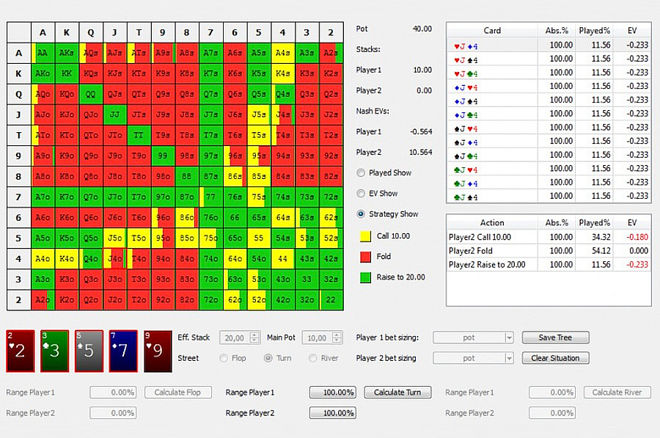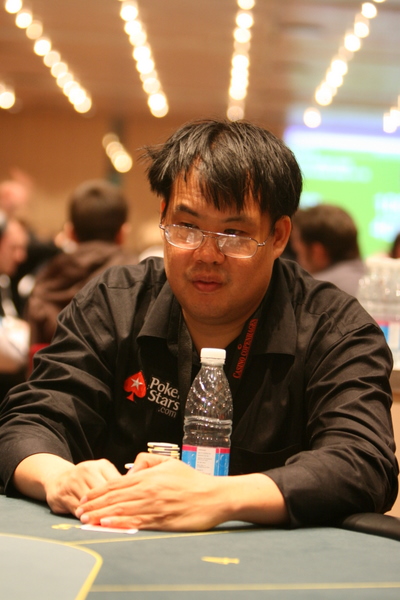- Poker Fold Equity Definition
- Poker Fold Equity Definition Government
- Poker Fold Equity Definition Synonyms
- Poker Fold Equity Definition Examples
Fold equity is possibly one of the most misunderstood terms in all of poker. If you Google 'fold equity', nearly half of the information you get is incorrect. This is not meant to be a comprehensive discussion of fold equity, it is meant to briefly address the importance of fold equity in NL SitNGo tournaments. Equity is our percentage chance to win a hand of poker assuming we are all-in. For example, in Hold'em, AA has 81.94% equity against KK. In practice, equity does not tell us the whole picture regarding how often we'll win, because either we or our opponent could end up folding some of the time. Fold equity is the equity you stand to gain based on the probability that your opponent will fold to a bet or raise. It is an important aspect of short-stack play, most often in tournaments.

Each week, the Talking Poker series highlights a particular poker term. We'll give you a clear, to-the-point definition of the term and an example of the strategic concept to which it refers, so that you can start using the term and implementing the related strategy into your game. Today we turn our attention to a commonly used term but perhaps not a commonly understood one — 'fold equity.'
Definition

'Fold equity' is a special use of the term 'equity' — one we discussed here a few weeks ago.
Whereas equity generally refers to your 'rightful' share of the pot as determined by your chance of winning it, fold equity more specifically represents the amount you stand to gain from the likelihood of your opponent folding to a bet.
In other words, if one player pushes all in versus another, the all-in player's current 'equity' would include both the money he stands to win if the other player calls his all-in bet and what he stands to win if his opponent decides to fold. It is the latter portion that is referred to as his 'fold equity' — that is, the additional equity over simple pot equity that can come from getting an opponent to fold rather than having to go to showdown.
The term is often used in a less technical sense simply to refer to the chance of getting a player to fold, especially in circumstances when folding is a desired outcome. (See 'Strategic Considerations' below for more.)
Example
In a no-limit hold'em tournament, it folds to Player A in the cutoff who has been dealt . With the blinds 300/600, he raises to 1,500. It folds to Player B in the big blind who looks down at and calls the raise. After preflop action is complete, Player A has 15,000, Player B has 10,000, and there is 3,300 in the pot. The flop comes and Player B checks.
With two more community cards to come, Player B has a 66.6% chance of having the best hand at showdown with that pair of fours, which in terms of simple pot equity would translate into having 66.6% equity of the pot at the moment. If they checked this hand down through the last two postflop streets and showed their hands, on average Player B would win 2,200 and Player A 1,100.
But despite having the worst hand, Player A has a number of other advantages, including position, initiative, and a bigger stack (and therefore the ability to knock out Player B). Plus, even though neither player knows the other's hand, Player B can't be too pleased by the three Broadway cards on the board, any of which could have likely hit Player A's hand.
Let's say that given all of these factors, if Player A makes a continuation bet there is a 75% chance Player B will fold. Player A's regular equity is only 33.4%; however, by betting the flop his overall equity increases with the additional fold equity gained by that 75% chance Player B will give up and fold.
With no continuation bet, there's zero fold equity to consider and Player A's equity remains 33.4% (or 1,100). By betting, Player A takes away (so to speak) 75% of the 66.6% equity Player B would have if Player A hadn't bet (75% x 66.6% = almost 50%). Player A's overall equity suddenly jumps from 33.4% up to 83.3% with the added fold equity, while Player B's is reduced similarly:
| Equity without Player A betting | Equity with Player A betting (including added fold equity) | |
|---|---|---|
| Player A | 33.4% (or 1,100 chips) | 83.3% (or 2,750 chips) |
| Player B | 66.6% (or 2,200 chips) | 16.6% (or 550 chips) |
Another way of looking at it — if Player A checks behind, his chance of winning the pot is just 1 in 3. But if he makes the continuation bet, his chance of winning the pot jumps to 5 in 6.

Player A bets 2,000 into the pot of 3,300, and Player B folds.
Strategic Considerations
Of course when playing a hand such as the one above, Player A cannot know precisely either actual equity (he doesn't know Player B's hand) nor fold equity (he doesn't know exactly what chance Player B will fold to a c-bet). But both can be estimated, and thus in terms of strategy it is good to have some idea how much betting can increase your chance of winning a hand by getting an opponent to fold.
Poker Fold Equity Definition
A common scenario in which fold equity is a prime strategic consideration is when a player becomes short-stacked in a tournament and is deciding whether or not to push all in. Advice about not becoming too short before pulling the trigger and shoving directly concerns fold equity, in fact. If you wait until you have only 3 big blinds left before going all in, the chances of getting opponents to fold go down considerably, giving you little additional fold equity when you shove. But if you push all in with 10 big blinds, that becomes a harder bet for others to call, thus giving you that additional fold equity.
Poker Fold Equity Definition Government
Similarly, when facing the all-in decision as a short stack, it is often recommended to push all in as the first raiser rather than reraise all in after someone else has raised, mainly because the player who opened is going to be more likely to call than would players who haven't put anything in the middle when you shove. If you a big hand like , , , or , you may want to be called; however, if you have or you may not necessarily want a call, and so gaining that fold equity when shoving is important.

These considerations apply as well to non-shoving situations as in the example above. Finding spots where your bets can elicit folds is a way of gaining fold equity and thus increasing your chances of gaining more chips, too.
Watch and Learn
During the recently completed PokerStars and Monte-Carlo®Casino EPT Grand Final in Monaco, our Remko Rinkema caught up with Jason Koon and asked him to explain further what fold equity is and how it affects strategic decisions.

Each week, the Talking Poker series highlights a particular poker term. We'll give you a clear, to-the-point definition of the term and an example of the strategic concept to which it refers, so that you can start using the term and implementing the related strategy into your game. Today we turn our attention to a commonly used term but perhaps not a commonly understood one — 'fold equity.'
Definition
'Fold equity' is a special use of the term 'equity' — one we discussed here a few weeks ago.
Whereas equity generally refers to your 'rightful' share of the pot as determined by your chance of winning it, fold equity more specifically represents the amount you stand to gain from the likelihood of your opponent folding to a bet.
In other words, if one player pushes all in versus another, the all-in player's current 'equity' would include both the money he stands to win if the other player calls his all-in bet and what he stands to win if his opponent decides to fold. It is the latter portion that is referred to as his 'fold equity' — that is, the additional equity over simple pot equity that can come from getting an opponent to fold rather than having to go to showdown.
The term is often used in a less technical sense simply to refer to the chance of getting a player to fold, especially in circumstances when folding is a desired outcome. (See 'Strategic Considerations' below for more.)
Example
In a no-limit hold'em tournament, it folds to Player A in the cutoff who has been dealt . With the blinds 300/600, he raises to 1,500. It folds to Player B in the big blind who looks down at and calls the raise. After preflop action is complete, Player A has 15,000, Player B has 10,000, and there is 3,300 in the pot. The flop comes and Player B checks.
With two more community cards to come, Player B has a 66.6% chance of having the best hand at showdown with that pair of fours, which in terms of simple pot equity would translate into having 66.6% equity of the pot at the moment. If they checked this hand down through the last two postflop streets and showed their hands, on average Player B would win 2,200 and Player A 1,100.
But despite having the worst hand, Player A has a number of other advantages, including position, initiative, and a bigger stack (and therefore the ability to knock out Player B). Plus, even though neither player knows the other's hand, Player B can't be too pleased by the three Broadway cards on the board, any of which could have likely hit Player A's hand.
Let's say that given all of these factors, if Player A makes a continuation bet there is a 75% chance Player B will fold. Player A's regular equity is only 33.4%; however, by betting the flop his overall equity increases with the additional fold equity gained by that 75% chance Player B will give up and fold.
With no continuation bet, there's zero fold equity to consider and Player A's equity remains 33.4% (or 1,100). By betting, Player A takes away (so to speak) 75% of the 66.6% equity Player B would have if Player A hadn't bet (75% x 66.6% = almost 50%). Player A's overall equity suddenly jumps from 33.4% up to 83.3% with the added fold equity, while Player B's is reduced similarly:
| Equity without Player A betting | Equity with Player A betting (including added fold equity) | |
|---|---|---|
| Player A | 33.4% (or 1,100 chips) | 83.3% (or 2,750 chips) |
| Player B | 66.6% (or 2,200 chips) | 16.6% (or 550 chips) |
Another way of looking at it — if Player A checks behind, his chance of winning the pot is just 1 in 3. But if he makes the continuation bet, his chance of winning the pot jumps to 5 in 6.
Player A bets 2,000 into the pot of 3,300, and Player B folds.
Strategic Considerations
Of course when playing a hand such as the one above, Player A cannot know precisely either actual equity (he doesn't know Player B's hand) nor fold equity (he doesn't know exactly what chance Player B will fold to a c-bet). But both can be estimated, and thus in terms of strategy it is good to have some idea how much betting can increase your chance of winning a hand by getting an opponent to fold.
Poker Fold Equity Definition
A common scenario in which fold equity is a prime strategic consideration is when a player becomes short-stacked in a tournament and is deciding whether or not to push all in. Advice about not becoming too short before pulling the trigger and shoving directly concerns fold equity, in fact. If you wait until you have only 3 big blinds left before going all in, the chances of getting opponents to fold go down considerably, giving you little additional fold equity when you shove. But if you push all in with 10 big blinds, that becomes a harder bet for others to call, thus giving you that additional fold equity.
Poker Fold Equity Definition Government
Similarly, when facing the all-in decision as a short stack, it is often recommended to push all in as the first raiser rather than reraise all in after someone else has raised, mainly because the player who opened is going to be more likely to call than would players who haven't put anything in the middle when you shove. If you a big hand like , , , or , you may want to be called; however, if you have or you may not necessarily want a call, and so gaining that fold equity when shoving is important.
These considerations apply as well to non-shoving situations as in the example above. Finding spots where your bets can elicit folds is a way of gaining fold equity and thus increasing your chances of gaining more chips, too.
Watch and Learn
During the recently completed PokerStars and Monte-Carlo®Casino EPT Grand Final in Monaco, our Remko Rinkema caught up with Jason Koon and asked him to explain further what fold equity is and how it affects strategic decisions.
Koon talks about both those late-tournament all-in-or-fold situations as well as how things like image and player reads come into play when estimating your chances of earning folds with bets. Take a look:
Poker Fold Equity Definition Synonyms
Get all the latest PokerNews updates on your social media outlets. Follow us on Twitter and find us on both Facebook and Google+!
Tags
cash game strategytournament strategypoker termsfold equityequityJason Kooncontinuation bettingno-limit hold'emEuropean Poker TourRelated Tournaments
European Poker TourRelated Players
Jason Koon
Poker Fold Equity Definition Examples
Fold equity is most often used during the latter part of a tournament when you need to steal blinds. It can be considered a form of bluffing. If your opponent only has, say, 10 times the blind, and you have 30 times the blind and place a large bet, your opponent may fold because he does not want risk a large portion (or all) of his stack. His or her fold is basically a safety play in which they prefer to wait for a stronger hand.
Knowing when you have fold equity and don't is essential to it being successful. Fold equity is an estimate of what another player will do and should take into account the opponents style of play (tight or loose), the opponents stack size, how much they already have in the pot (be careful if an opponent is pot committed!), and your stack size and table image.
The main idea being using fold equity is to get your opponent to fold because calling your bet will be too expensive for comfort.
Find out more about fold equity in this video.

